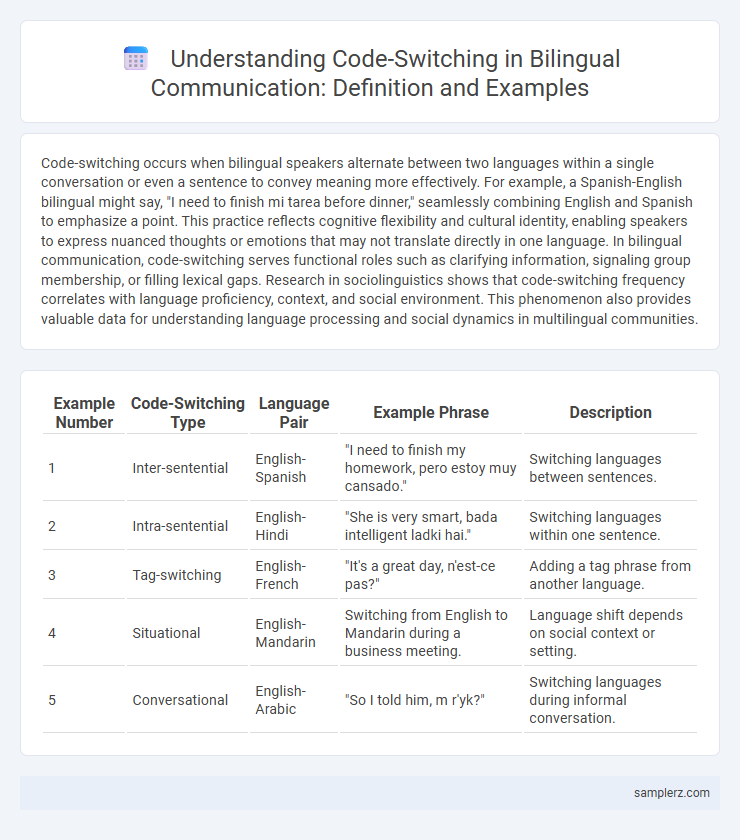Code-switching occurs when bilingual speakers alternate between two languages within a single conversation or even a sentence to convey meaning more effectively. For example, a Spanish-English bilingual might say, "I need to finish mi tarea before dinner," seamlessly combining English and Spanish to emphasize a point. This practice reflects cognitive flexibility and cultural identity, enabling speakers to express nuanced thoughts or emotions that may not translate directly in one language. In bilingual communication, code-switching serves functional roles such as clarifying information, signaling group membership, or filling lexical gaps. Research in sociolinguistics shows that code-switching frequency correlates with language proficiency, context, and social environment. This phenomenon also provides valuable data for understanding language processing and social dynamics in multilingual communities.
Table of Comparison
| Example Number | Code-Switching Type | Language Pair | Example Phrase | Description |
|---|---|---|---|---|
| 1 | Inter-sentential | English-Spanish | "I need to finish my homework, pero estoy muy cansado." | Switching languages between sentences. |
| 2 | Intra-sentential | English-Hindi | "She is very smart, bada intelligent ladki hai." | Switching languages within one sentence. |
| 3 | Tag-switching | English-French | "It's a great day, n'est-ce pas?" | Adding a tag phrase from another language. |
| 4 | Situational | English-Mandarin | Switching from English to Mandarin during a business meeting. | Language shift depends on social context or setting. |
| 5 | Conversational | English-Arabic | "So I told him, m r'yk?" | Switching languages during informal conversation. |
Understanding Code-Switching in Bilingual Communication
Code-switching in bilingual communication involves alternating between two languages within a conversation to convey meaning more effectively. For example, a Spanish-English bilingual might say, "Let's meet at the parque this afternoon," seamlessly mixing English and Spanish to express a cultural nuance or emphasis. This linguistic behavior enhances understanding by bridging gaps in vocabulary and cultural context, facilitating smoother interaction.
Everyday Code-Switching Scenarios
Everyday code-switching commonly occurs in bilingual conversations when speakers alternate between languages to express ideas more precisely or convey cultural nuances. For instance, a Spanish-English bilingual might say, "I'm going to the tienda to buy some groceries," effortlessly mixing English and Spanish in a single sentence. This linguistic flexibility enhances communication efficiency and fosters connection within bilingual communities.
Code-Switching in Family Conversations
In bilingual family conversations, code-switching frequently occurs as speakers alternate between languages to express emotions, clarify meanings, or convey cultural nuances more effectively. For instance, a Spanish-English speaking family might say, "Can you pass me the salt, por favor?" blending English requests with Spanish politeness markers. This linguistic flexibility enhances mutual understanding and maintains cultural identity within the household.
Classroom Code-Switching Among Students
Classroom code-switching among bilingual students often involves alternating between their native language and the target language to clarify complex concepts or express cultural identity. For instance, Spanish-English bilingual students may switch to Spanish for technical explanations while using English for general classroom interactions. This dynamic linguistic strategy enhances comprehension and social bonding within multilingual educational environments.
Workplace Code-Switching: Professional Interactions
Workplace code-switching frequently occurs when bilingual employees alternate between languages to enhance clarity, build rapport, or navigate cultural nuances in professional interactions. For example, a Spanish-English bilingual manager might switch to Spanish during team meetings to convey empathy and reinforce group identity while using English for formal reports and client communications. This strategic language shift not only facilitates effective communication but also strengthens workplace relationships and inclusivity.
Social Media and Digital Code-Switching
Code-switching on social media frequently involves bilingual users alternating between languages within posts, comments, or messages to convey cultural identity or emphasize particular ideas. Digital code-switching also includes mixing languages in hashtags, emojis, and acronyms to engage diverse audiences and enhance interaction. Platforms like Twitter and Instagram showcase dynamic examples where code-switching bridges linguistic communities and enriches online social communication.
Code-Switching in Multicultural Friendships
Code-switching in multicultural friendships often involves fluidly alternating between languages to express emotions or cultural nuances more precisely, enhancing mutual understanding. For example, a bilingual friend group might switch from English to Spanish when sharing personal stories to convey warmth or humor authentically. This linguistic flexibility strengthens social bonds and reflects the dynamic identity of multicultural communities.
Code-Switching in Public Announcements
Code-switching in public announcements often occurs when bilingual speakers alternate between languages to effectively reach diverse audiences, such as using Spanish and English in city council updates. This linguistic strategy enhances clarity and cultural relevance, ensuring key information resonates with multiple language communities. Examples include emergency alerts or public health messages that dynamically switch languages to maximize comprehension and inclusivity.
Code-Switching in Customer Service Situations
In bilingual customer service interactions, code-switching often occurs when representatives alternate between languages to clarify product details or resolve issues, enhancing understanding and rapport. For example, a Spanish-English bilingual agent might switch to Spanish to explain complex return policies more effectively to a Spanish-speaking customer. This strategic language alternation improves communication efficiency and customer satisfaction by addressing linguistic preferences and cultural nuances.
Creative Expression: Code-Switching in Art and Music
Code-switching in bilingual communication often manifests as a dynamic tool for creative expression in art and music, blending linguistic elements from multiple languages to enhance emotional resonance and cultural depth. Artists and musicians integrate code-switching to reflect identity, create unique soundscapes, and engage diverse audiences, enriching storytelling with authentic multilingual narratives. This linguistic interplay fosters innovation by merging cultural references and linguistic styles, making code-switching a powerful expressive device in contemporary artistic practices.

example of code-switching in bilingual communication Infographic
 samplerz.com
samplerz.com